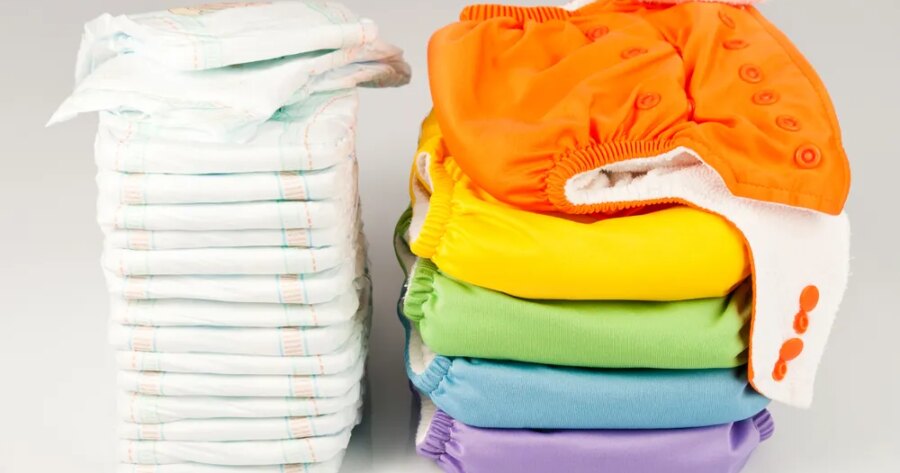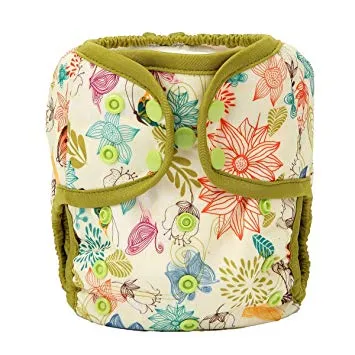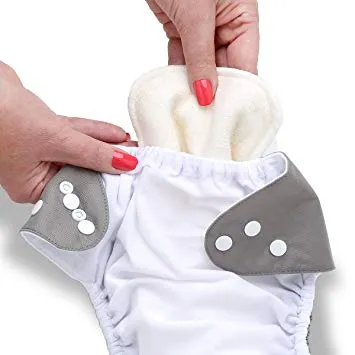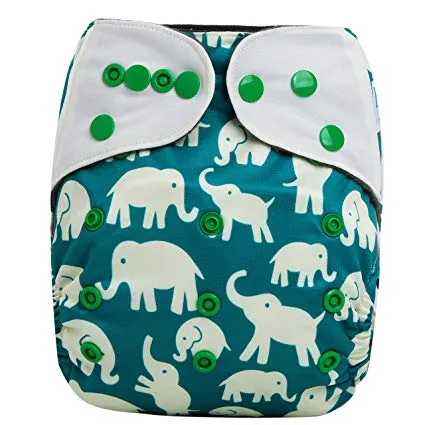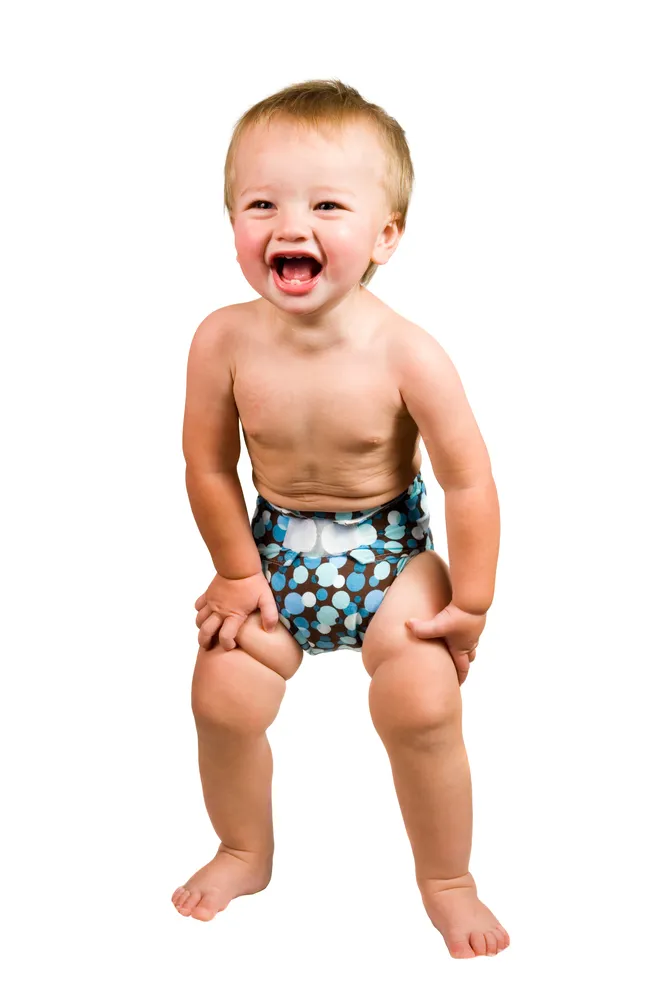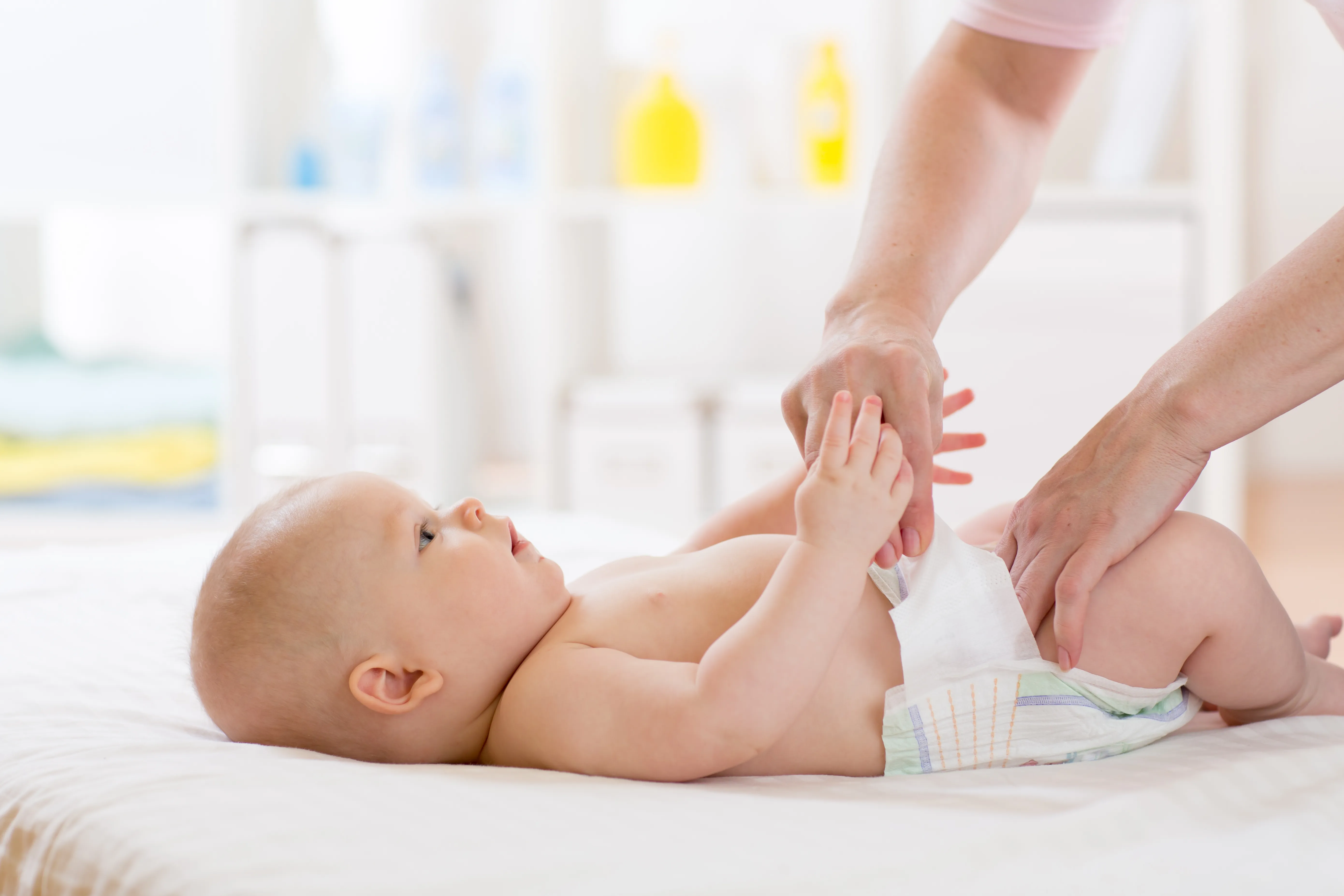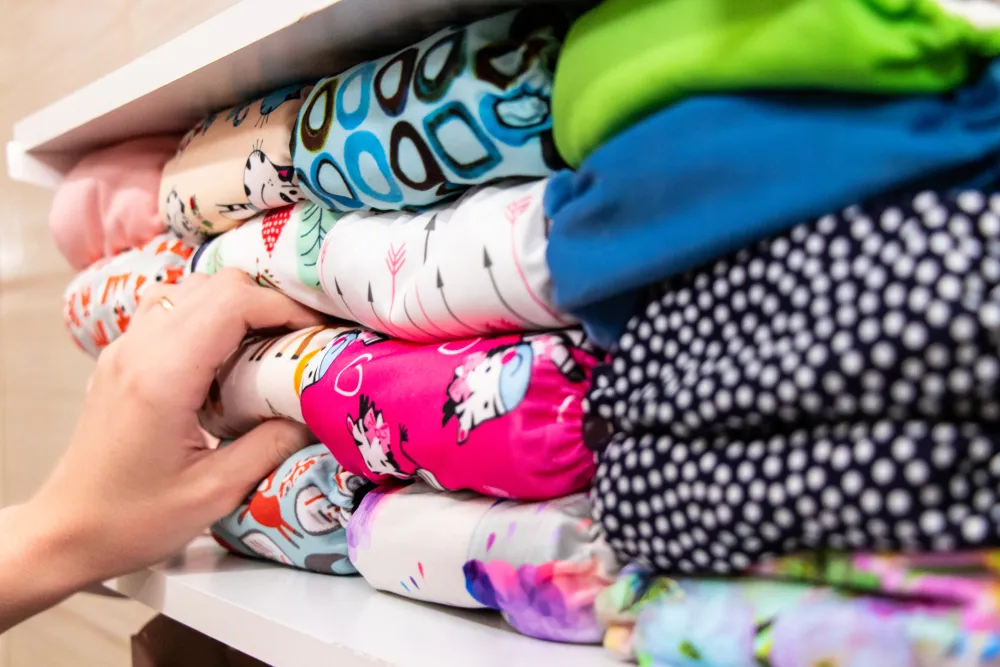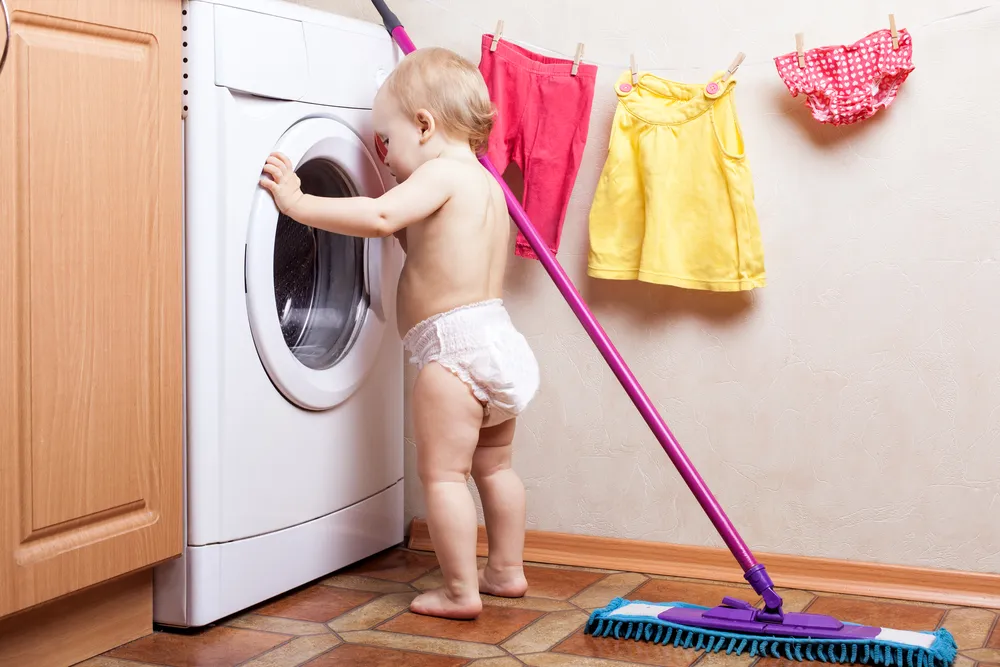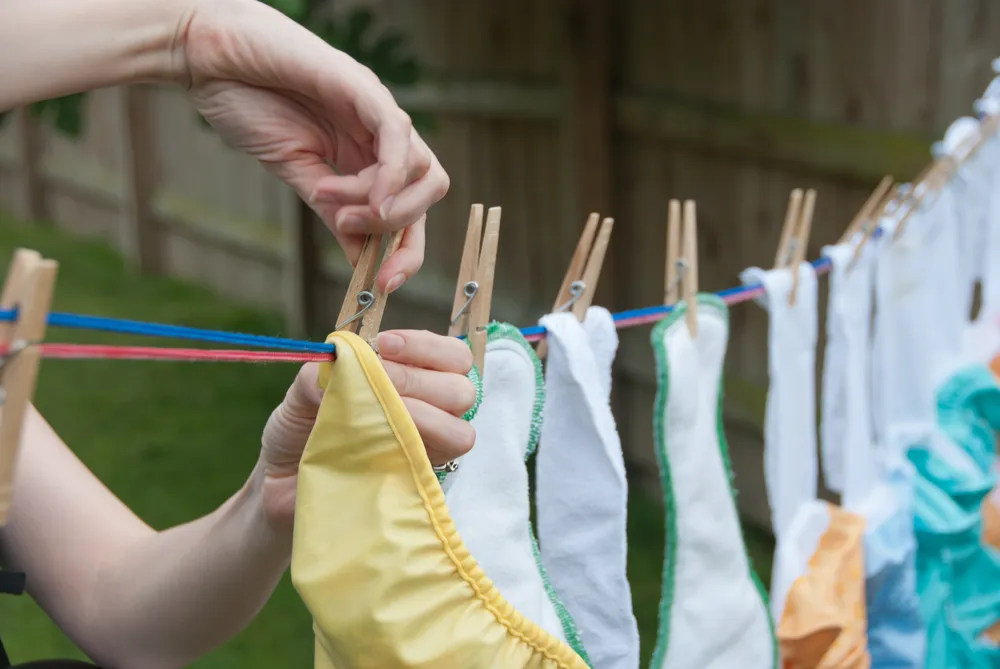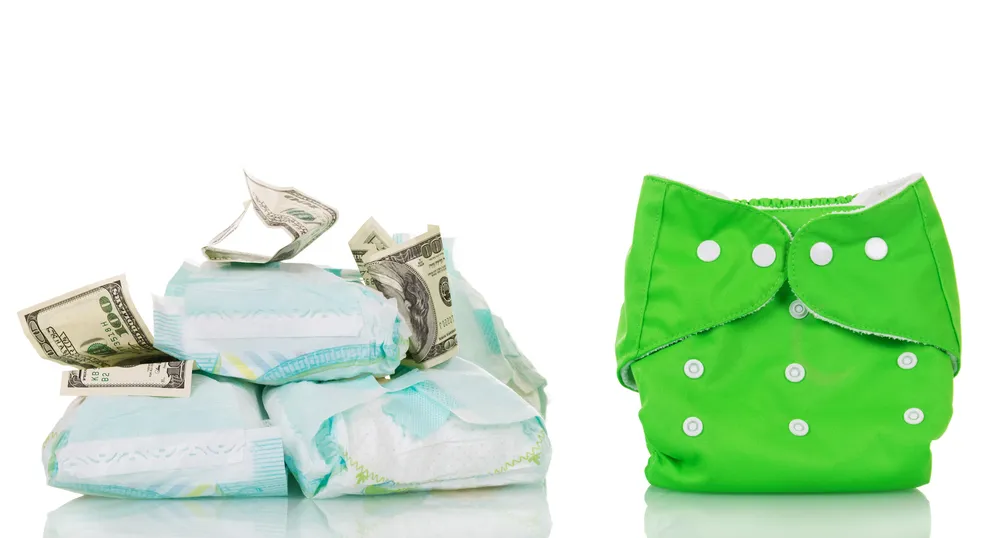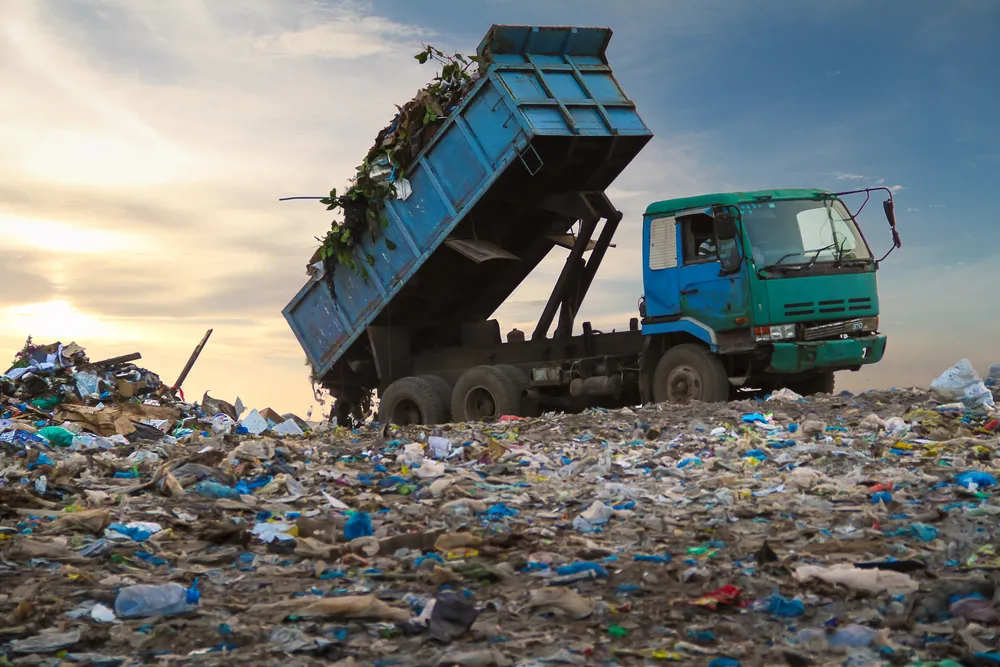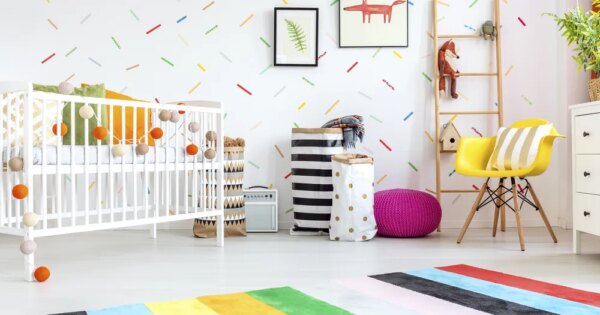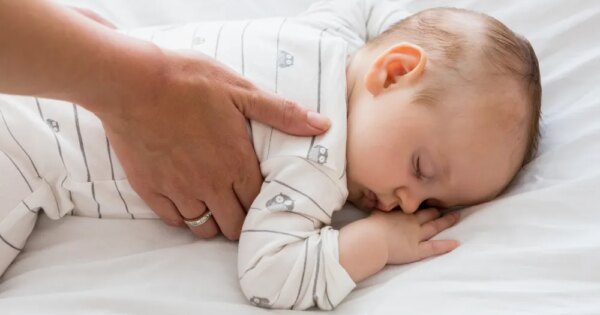Cloth vs. Disposable. For me, it wasn’t even a question. The thought never even crossed my mind to go the cloth-diaper route — I thought it would be way to messy and labor intensive to me and my husband. But to be honest, I never really sat down and weighed the pros and cons to each. However, if you are expecting a child, it is worth taking the time and weighing your options, because nowadays you should know, a case can be made for both. Even if you have always planned to be a disposable-diaper parent, maybe by the end of this read, you may have changed your mind. Or, maybe you will still be on team-disposable! Either way, here is the low-down on both cloth and disposable diapering.
Cloth diapers have certainly come a long, long way. Gone are the days with complicated folds and safety pins. Cloth diapers are much quicker and easier to use now with their Velcro or snap closure options — making them debatable as easy as using disposable diapers. They come in various types: Prefold, Fitted, Covers, Pocket, All-in-one, and All-in two. I will go into more detail and tell you a bit about each types design below. Which will you choose? Cloth? Or Disposable? I hope this will help you to decide which one makes the most sense for you and your family’s lifestyle and needs.
Prefold Diapers
Prefolds are rectangular diapers with more layers of cotton (or chosen fabric) sewn into the center, and less layers of fabric on each side. Most prefolds are 4x8x4 layers. The most common prefolds are Chinese or Indian.
In addition to cotton, other fabrics in prefold diapers include: bamboo, microfiber and micro fleece. It is important to note that microfiber should not come in direct contact with your child’s skin — so layer the top with one of the other fabrics and keep the microfiber in the middle or bottom layer, if used.
Buy On Amazon: Pre-Fold Cloth Diapers
Fitted Diapers
Fitted diapers, which are also commonly referred to as Fitteds, closely resemble the size and shape of disposable diapers, but are ingenious cloth diapers which combine ease of use and flexibility. They can come in a variety of super absorbent, breathable, natural fiber materials including: cotton, wool, bamboo, hemp, fleece or terry cloth.
Fitted diapers are not waterproof! They do require the use of a diaper cover, however, some parents choose to go coverless for more breathability (usually when trying to clear up diaper rash). Otherwise, for waterproof protection, these can be used in combination with a PUL (Polyurethan Laminate) diaper cover — more on these below.
Buy on Amazon: Fitted Diapers
Diaper Covers
A diaper cover provides the waterproof layer needed to keep your child’s clothing dry when using cloth diapers (such as prefolds or fitted diapers). Covers can come in both sizable options or one size fits all.
With diaper covers, you simply replace the absorbent liner portion and continue using the cover, rather than requiring a new diaper cover each diaper change. Should you get any mess on the cover, you can either wipe it up (if possible) and reuse, or for heavy messes you may choose to toss it in the wash and just use a new cover.
Buy on Amazon: Diaper Covers
Pocket Diapers
A pocket style diaper has a pocket opening between the outer waterproof shell (or cover) and the still-absorbent, soft inner layer that touches baby’s skin. You can place the absorbent material insert inside this pocket opening to keep it secured in place.
These are nice, because you can still customize them and increase absorbency by adding more inserts inside the pocket for added protection. However, pocket diapers are not reusable in that after they are soiled. Because the outer waterproof shell has the absorbent pocket liner (that comes in contact with baby’s skin) built right in, you cannot wipe up messes and reuse it. You will need a new one for each diaper change, and the soiled diaper (and it’s inserts) must be then tossed in the wash before reusing it again. But, the advantage of the pocket diaper still, is that it is pretty easy to clean since the inserts aren’t directly exposed to the poop, it will be quicker and easier to wash (spray) off.
Buy on Amazon: Pocket Diapers
All-In-One
All-in-One Cloth Diapers (also known as “AIO”s) are the easiest diapers to use and have the absorbent material sewn into the diaper cover. The sewn-in inserts may be natural fibers or synthetic fibers. These diapers will fasten with either snaps or Velcro.
All-in-One system cloth diaper options are most like a disposable diaper and give the same type of experience of taking off the soiled diaper and tossing it — but rather than tossing it in the garbage, you toss it into the wash. It is also similar in the sense as you go through a whole diaper every change, rather than replacing a insert or liner and reusing (like you would with the diaper cover & prefold insert combo option or the All-in-two, mentioned below).
Buy on Amazon: All-In-One Diaper
All-In-Two
An all-in-two Cloth Diaper (also known as “AI2″s) is a two-piece system in which an absorbent insert (sometimes referred to as a soaker pad) is laid or snapped inside a waterproof cover/shell. You can customize these too by removing or adding inserts as needed.
The difference between the AIO and the AI2 is because the shell of the AIO diaper can not be wiped out and be used again once it is soiled, it is an AIO not an AI2. The shell of the AIO is also thick and absorbent and works in conjunction with its absorbent pads that are built in. With the AI2, you can normally wipe the inside out (since it doesn’t have that same absorbent material built right in) and snap the insert(s) out and just replace the inserts. This allows you to use less diapers and gives you less laundry. Technically speaking, you may consider using a prefold (or flat) with a cover an AI2 style, but because the absorbent parts do require some folding it is not a true AI2 diaper. The AI2 is quicker to use and is an updated simpler version of using a prefold and cover. You may also consider a pocket diaper to be an AI2 diaper because it also has two parts — the water proof soaker cover & the absorbent inserts. But, the defining feature that separates pocket diapers from A12’s is the pocket! Instead of laying the inserts on top or snapping them in, you tuck them into the pocket, which may require a tiny bit more effort.
Buy on Amazon: All-In-Two Diapers
Disposable Liners
Before moving on to discuss disposable diapers, I felt I need to add one additional note that apply’s to any of the above cloth diapers. With any of these diapers, you may wish to line all of your little ones diapers with a disposable liner on the very top, this way baby poops can be picked right up and flushed right down the toilet, making clean up even easier!
Disposable liners are relatively expensive — maybe $7 for a roll of 100. Having this additional disposable liner might be just what you need to make cloth diapering that much easier and quicker, making the cleaning experience simplified less messy.
Buy on Amazon: Disposable Liners
Disposable Diapers
Disposable diapers are made of synthetic disposable materials and contain absorbent chemicals and are thrown away after use. Disposable diapers are very simply designed with tabs that pull and fasten with ease on the front of the diaper. Unlike cloth diapers that can grow with your child, disposable diapers are available in a variety of sizes from newborn through size six, that will be best fit to your child based on their weight and age.
No additional liners required! Disposable diapers are a one-piece ready-to-use option, as compared to most of their cloth counterparts. Careful not to pull too hard on the tab, as they can rip and be rendered useless. This is what I consider to be the only downfall to the disposable diapers design. Otherwise, no major complaints when it comes to functionality.
Materials – Cloth vs Disposable
Cloth diapers are available in various soft fabrics including: cotton, terry cloth or flannel – to name a few. So soft on baby’s skin, when it comes to material — cloth diapers win out on the material comfort factor. Cloth diapers also do not contain any dyes or gels, making it a more natural way of diapering. Another fun feature of cloth diapers is that they can come in so many fun colors and patterned designs, they are almost an accessory for your little one. They can be quite fashionable and cute!
Disposable diapers are considered the less natural option, as they do contain dyes and gels. There are no studies to know if they can do any harm to your little one, however, some babies can be allergic to the gels and dyes used, which can lead to more diaper rashes and skin irritations for babies with sensitive skin. The multiple size option however makes it possible for you to customize their fit to their body size, making them not only comfortable, but preventing as many leaks as possible when they are securely and properly fit.
Comfort
When it comes to comfort, there are no huge differences between cloth and disposable diapers, so long as you change your baby’s diaper when it has been soiled. Leaving on a soiled diaper (whether cloth or disposable) increases your child’s risk of getting a diaper rash, which does not feel so comfortable for baby. Cloth diapers can be less absorbent, and will require more frequent changes to keep baby dry and comfortable.
Disposable diapers however, are more absorbent keeping baby feeling dryer longer –as the absorbent built-in liners wick moisture away from them, allowing them to feel more comfortable for longer periods of time. Disposable diapers are also more breathable than most cloth diapers, making them even more comfortable for little ones.
Time
Even though it can be argued that the more recent design of cloth diapers have become much easier to use, disposable diapers is a clear winner when it comes to time required to change a diaper. No changing liners or removing of the soiled contents involved! Just wrap it up and toss!
The closest runner up when it comes to change time would be the AIO diaper — that you can simply toss right into the wash. However, parents may still choose to do a slight pre-rinse clean getting the major contents disposed of before tossing into the wash — especially if they don’t use the added disposable liner. A bit extra time — but honestly, they are sure giving disposables a run for their money!
Convenience
As mentioned earlier, cloth diapers have come a long way, and when it comes to convenience, they are becoming more and more comparable to disposable diapers. The daunting, complicated folds and scary pins moms had to deal with in the past, is no longer a thing. Great improvements have been made, and pins have now been replaced with much more user-friendly Velcro or snap closures making changing time just as quick and easy as with a disposable.
Cloth diapers also come with well-designed shapes fitted to baby. With the addition of waterproof bands around the waist and legs to prevent leaks, and removable linings — cloth diapers work just as hard as a disposable. It is however important to keep in mind that cloth diapers still aren’t quite as absorbent as their disposable counterparts, so you’ll have to change them more often — especially if you want to prevent your little one from getting a diaper rash, which can be more common in cloth-diapered little ones.
Upfront Costs of Cloth Diapers
You can spend anywhere from $7 to $20 on good, long lasting cloth diapers. You will want to have 8 to 10 diapers available to use each day, so you will want to have a stash of 24 to 30 diapers on hand. For easy calculation purposes, lets say we bought diapers at $15/diaper and we bought 25 diapers — your upfront cost for cloth diapers would be $375.
You may also need to add the cost of inserts (unless you buy ones with the inserts included). Reusable inserts cost about $2 each. Again, for easy calculation purposes, lets say we bought 2 x 12 pack of inserts at $30 each — your upfront cost for cloth diaper inserts would be $60. So, your total upfront costs would be about $435.
Indirect Costs of Cloth Diapers
Indirect costs of cloth diapering would include your water usage and energy costs for the additional laundry you will be doing. You should expect washing cost of cloth diapers to be no more than $100/year. Additional costs may include things such as a diaper sprayer (to get solids of the cloth diaper before you wash it), and/or disposable diaper liners that can be placed inside their diaper to catch solid waste for easy disposable into the toilet for flushing.
A roll of disposable liners costs about $7 for a roll of 100 liners — so this could be an added cost you may find to be worth it for making clean up of poopy messes easier! So, again for easy calculation purposes, lets say you will spend $300 — for one child’s clean up costs of cloth diapering every year until your child is potty trained.
Total Cost of Cloth Diapering
Parents can look at expecting to spend about $375 (cloth diapers) + $60 (reusable inserts) + $300 (indirect costs — including water, energy and additional clean up costs) for a total initial investment of $735 per year. Again, this number obviously is dependent on how many diapers you buy and how high-end they are.
The big savings will come in the second year! You will have already made your initial investment in the diapers and reusable liners, so the only cost incurred in the second year would be the Indirect Costs (estimated at $300). So, if your child wore diapers until they were 3 years old, it would cost you a total of about: $735 + $300 + $300 = $1,335 until they were potty trained.
Total Cost of Disposable Diapers
Now, lets look at the cost of disposable diapers! For easy calculation purposes, lets say that you will change your child’s diaper on average 8 times a day x 365 days, at an average cost of $0.25/disposable diaper. This would calculate to be about $730 for disposable diapers in their first year of life. So, if your child wore disposable diapers until they were 3 years old, it would cost you a total of about: $730 + $730 + $730 = $2,190 until they were potty trained.
So, when you compare this 3-year cost of each type, you will see a savings of: $2,190 – $1,335 = $885. But, you must also keep in mind that you can reuse cloth diapers on any new siblings that come along! So, this will of course contribute to even GREATER savings as the major investment in the cloth diapers and liners themselves has already been made and taken into account in the first child’s first year of life. For any subsequent children, the only cost would be the indirect costs (estimated at $300) for each year of their life (until they were potty trained)! Furthermore, after all of your little ones are out of diapers, you can even then turn around and sell your cloth diapering supplies, and regain back even more of that initial investment you had made for even greater savings!
Environment
After we just discussed the money savings that cloth diapers can provide over disposable diapers, we must also talk about the environmental savings! It may not be as clear cut as you might think for cloth diapers vs. disposable. Yes, disposables use resources like trees and plastics during their manufacturing, then collect in landfills (most are 40 percent biodegradable). But, consider the process of washing cloth diapers—clean water and energy are used up, and nothing but dirty water is produced.
So, cloth diapers are the winners when it comes to being more environmentally friendly. Disposable diapers really aren’t the greenest. They account for 3.4 million tons of landfill each year, and they don’t decompose easily. Biodegradable or not, very little breaks down in a landfill. If you flushed solids down the toilet you can significantly reduce that waste — but lets be honest, this isn’t something that many people do. One point cloth diapers, zero points disposable diapers on this one!
Impact on Potty Training
When it comes to potty training, it is believed that children in cloth diapers may be easier to start potty training with. Because children feel wet sooner (more similar to if they were wearing underpants) they will not enjoy this uncomfortable feeling. Disposable diapers do such a good job at pulling moisture away from their skin, that they don’t realize they are wet as soon. This can make them feel more comfortable longer, and thus in less of a hurry to get out of them and start potty training!
Now, after comparing all of the differences of cloth vs disposable, I hope you have been well informed, and feel more confident in your decision for either method. Everyone is different, so you will do what works best for your family! Happy diapering!
